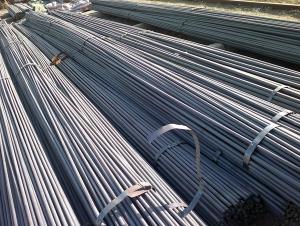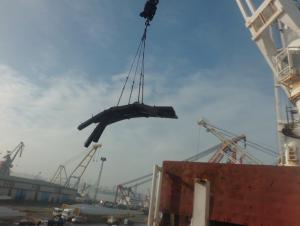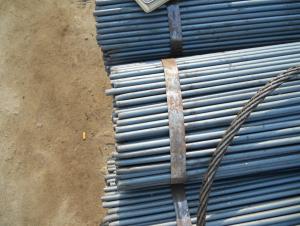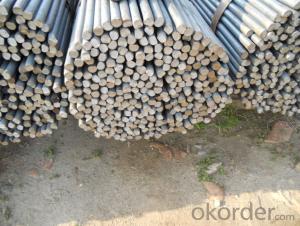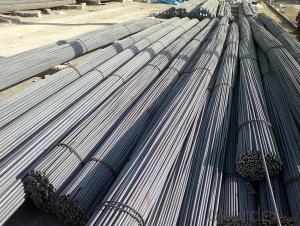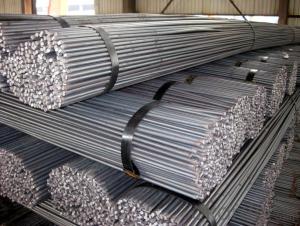steel round bar
- Loading Port:
- China Main Port
- Payment Terms:
- TT OR LC
- Min Order Qty:
- -
- Supply Capability:
- -
OKorder Service Pledge
OKorder Financial Service
You Might Also Like
Specifications of High Quality Round Bar
1. Grade: GB, JIS, ASTM, EN
2. Grade: Q235, SS400, A36, S235JR
3. Diameter and mass: As below
Diameter | Mass | Diameter | Mass | Diameter | Mass |
(mm) | (kg/m) | (mm) | (kg/m) | (mm) | (kg/m) |
6 | 0.22 | 22 | 2.98 | 53 | 17.30 |
7 | 0.30 | 24 | 3.55 | 56 | 19.30 |
8 | 0.40 | 25 | 3.85 | 60 | 22.20 |
9 | 0.50 | 26 | 4.17 | 63 | 24.50 |
10 | 0.62 | 28 | 4.83 | 65 | 26.00 |
11 | 0.75 | 30 | 5.55 | 70 | 30.20 |
12 | 0.89 | 32 | 6.31 | 75 | 34.70 |
13 | 1.04 | 34 | 7.13 | 80 | 39.50 |
14 | 1.21 | 36 | 7.99 | 85 | 44.50 |
15 | 1.39 | 38 | 8.90 | 90 | 49.90 |
16 | 1.58 | 40 | 9.86 | 95 | 55.60 |
17 | 1.78 | 42 | 10.90 | 100 | 61.70 |
18 | 2.00 | 45 | 12.50 | 120 | 88.85 |
19 | 2.23 | 48 | 14.20 | 140 | 120.93 |
20 | 2.47 | 50 | 15.40 | 150 | 138.82 |
4. Material: Mild Steel
5. Heat treatment of high quality steel:
Fire: Isothermal annealing temperature is 800 ~ 880 °C, with 10 ~ 20 °C, the furnace cooling to about 600 °C, hardness above HB269.
Preheat temperature: 730-730 °C
Quenching temperature: 1190-1210 °C
Tempering temperature: 540-595 °C
Cold drawn, hardness 285 HBS
Cold drawn after annealing condition, hardness 277 HBS
Quenching methods: oil quenching, air cooling or salt bath quenching
Usage and Applications of High Quality Round Bar
1) Suitable for making various strong cutting tool abrasion resistance, impact resistance.
2) Used to produce all kinds of high hard and super hard saw blade, drill, tap, broach, gear hob and various kinds of milling cutter.
3) Used for advanced punching die, screw die, and the toughness and complicated shape of the punch, etc.
4) Is used for cold forging die and drawing mode, etc.
5) Recommended watchcase factory, screw factory and other cold stamping products industry use.
Packaging & Delivery of High Quality Round Bar
Packaging Detail: All goods are packed in bundle with steel strips and shipped by break bulk vessel or container (depend on target market and different ports)
Delivery Detail: 45 days
Trade terms: FOB, CFR, CIF
MOQ: 25 tons per specification; we can negotiate the quantity if the specification is normal or we have stock of one specification.
Weight: The price invoicing on theoretical weight basis or actual weight basis depends on customer’s request.
Shipment: The shipment of bulk break or container is depends on customer’s request and the situation of the port of destination.
Documents given: Full set of original clean on board bill of lading; Original signed commercial invoice; Original packing list; Policy of insurance; Certificate of origin and what the target market needs.
Production Flow of High Quality Round Bar
The common processes are preheated forging quenching, dual refinement solution process, cooling quenching and isothermal quenching. We use heat treatment for dual refinement solution process. The main measures process is high temperature solution and refinement cycle. High temperature solution can improve the carbide morphology and particle size. The aim is to make the loop refinement ultrafine austenite grains.
- Q:How do you calculate the shear strength of a steel round bar?
- The shear strength of a steel round bar can be calculated by using the formula: Shear Strength = 0.6 * Ultimate Tensile Strength Where the Ultimate Tensile Strength is the maximum stress a material can withstand before failure.
- Q:Can steel round bars be bent or shaped?
- Certainly! Steel round bars have the capability to undergo bending and shaping. Steel, being a highly malleable material, can be formed into desired shapes through different processes. Techniques such as hot bending, cold bending, or induction bending can be employed to bend the steel. By applying force to the steel bar, it can be deformed and molded into the desired shape. Moreover, machining processes like turning, drilling, milling, or grinding can also be utilized to shape steel round bars. These processes enable the creation of various profiles, including cylindrical, square, or hexagonal shapes, among others. In summary, steel round bars provide great flexibility for bending and shaping, allowing for their versatile use in a wide range of applications.
- Q:What are the advantages of using steel round bars in construction?
- Using steel round bars in construction offers several advantages: Firstly, steel round bars are known for their exceptional strength and durability. They possess a high tensile strength, allowing them to bear heavy loads and provide robust support. This makes them ideal for construction projects that require structural integrity and stability. Secondly, steel round bars provide versatility in construction. They come in various sizes and grades, allowing for easy shaping, bending, and welding to fit specific design requirements. This adaptability makes them suitable for a wide range of applications, such as building frameworks, reinforcing concrete structures, or even adding decorative elements. Thirdly, steel round bars offer cost-effectiveness in construction. They have a long lifespan and require minimal maintenance due to their resistance to corrosion, weathering, and pests. Moreover, their strength allows for the use of lighter construction materials, potentially reducing overall project costs. Additionally, steel round bars have excellent fire-resistant properties, making them a safe choice for construction. They do not burn, melt, or emit toxic fumes under high temperatures, which is essential in preventing the spread of fire and ensuring occupant safety. Furthermore, using steel round bars in construction contributes to sustainability. Steel is 100% recyclable and using recycled steel helps minimize waste and conserve natural resources. The recycling process also requires less energy compared to manufacturing steel from raw materials, making it an eco-friendly choice. Moreover, steel round bars are readily available in the market, making them easily accessible for construction projects. Additionally, their production undergoes strict quality control measures, guaranteeing consistent and reliable material properties. This ensures the structural integrity and safety of the constructed buildings or infrastructures. In conclusion, the advantages of using steel round bars in construction include their strength, versatility, cost-effectiveness, fire resistance, sustainability, availability, and quality control. These attributes make them a popular choice for builders and engineers seeking reliable and efficient materials for their construction projects.
- Q:Are steel round bars suitable for decorative purposes?
- Yes, steel round bars can be suitable for decorative purposes. They can be used in various architectural and interior design applications to create a modern and industrial aesthetic. Steel round bars can be shaped, polished, or painted to enhance their decorative appeal and add a stylish touch to furniture, fixtures, sculptures, and other artistic creations.
- Q:Can steel round bars be cold worked?
- Steel round bars are capable of being cold worked. Cold working involves the plastic deformation of a metal at temperatures below its recrystallization point. This method is frequently employed to enhance the strength and hardness of steel round bars. Cold working can be accomplished through different techniques, including cold rolling, cold drawing, and cold forging. These procedures exert compressive forces on the steel, leading to shape alteration without the requirement of heating. Cold working can yield improved mechanical characteristics, heightened dimensional precision, and a more polished surface texture for steel round bars.
- Q:How do you identify the grade of a steel round bar?
- The grade of a steel round bar can be identified through several methods. One way is to check the markings or labels on the bar itself. Manufacturers often stamp or engrave the grade directly onto the surface of the bar. These markings typically include information such as the grade designation (e.g., 304, 316, 4140), which represents the specific alloy composition, and may also include additional details such as the heat or lot number. Another method is to refer to the mill test certificate (MTC) that accompanies the steel round bar. The MTC provides comprehensive information about the composition, mechanical properties, and other relevant specifications of the material. The MTC is usually issued by the steel mill or supplier and can be requested upon purchase. Moreover, visual inspection and physical testing can help identify the grade of a steel round bar. Visual inspection involves observing the bar's appearance, texture, and color. Different grades of steel may exhibit distinct characteristics, such as a shiny or matte finish, specific surface treatments, or variations in color due to different alloying elements. Physical testing methods, such as tensile or hardness testing, can provide further confirmation of the steel grade. These tests measure the mechanical properties of the material, such as its strength, ductility, and hardness. By comparing the test results with known standards and specifications for different steel grades, one can determine the grade of the round bar. In summary, to identify the grade of a steel round bar, one can check for markings on the bar, refer to the mill test certificate, visually inspect the bar, and perform physical tests to assess its mechanical properties.
- Q:Are steel round bars corrosion resistant?
- No, steel round bars are not inherently corrosion resistant. Steel is primarily made of iron, and iron is prone to rusting when exposed to moisture and oxygen. However, there are certain types of steel that are specifically designed to be corrosion resistant. These types of steel, such as stainless steel, contain additional alloying elements like chromium and nickel, which form a protective layer on the surface of the steel, preventing rust and corrosion. So, while regular steel round bars are not corrosion resistant, there are corrosion-resistant options available in the form of stainless steel round bars.
- Q:Can steel round bars be polished?
- Yes, steel round bars can be polished.
- Q:What are the common alloying elements used in steel round bars?
- The common alloying elements used in steel round bars are carbon, manganese, silicon, and sometimes chromium, nickel, and molybdenum.
- Q:Can steel round bars be used for making fasteners?
- Yes, steel round bars can be used for making fasteners. They are commonly used in the manufacturing of bolts, screws, and other types of fasteners due to their strength, durability, and ease of machining. Steel round bars provide the necessary mechanical properties and can be threaded or shaped to meet specific fastening requirements.
1. Manufacturer Overview |
|
|---|---|
| Location | |
| Year Established | |
| Annual Output Value | |
| Main Markets | |
| Company Certifications | |
2. Manufacturer Certificates |
|
|---|---|
| a) Certification Name | |
| Range | |
| Reference | |
| Validity Period | |
3. Manufacturer Capability |
|
|---|---|
| a)Trade Capacity | |
| Nearest Port | |
| Export Percentage | |
| No.of Employees in Trade Department | |
| Language Spoken: | |
| b)Factory Information | |
| Factory Size: | |
| No. of Production Lines | |
| Contract Manufacturing | |
| Product Price Range | |
Send your message to us
steel round bar
- Loading Port:
- China Main Port
- Payment Terms:
- TT OR LC
- Min Order Qty:
- -
- Supply Capability:
- -
OKorder Service Pledge
OKorder Financial Service
Similar products
New products
Hot products
Hot Searches
Related keywords
